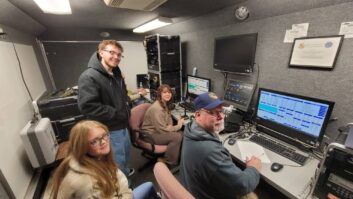Field Report: Neumann BCM 705
Jul 1, 2005 12:00 PM, By Doug Irwin
I’ve always considered Neumann microphones to be the “gold standard,” but I’ve had little experience with them (save the U87). Georg Neumann founded the company in Berlin in 1928, and over the years developed and introduced 90 microphone models. Sennheiser took over the company in 1991 and has taken excellent care in maintaining the Neumann brand; Sennheiser has also facilitated a marked increase in the ability of Neumann to produce enough units to lower the price point and to likewise build up Neumann’s market share. The TLM-103, the KMS-105 and the newly introduced BCM 104 come to mind; but unlike those three, the BCM 705 is a dynamic microphone � the first ever built with the Neumann name.

The transducer element itself in the BCM 705 is a variation of the Sennheiser MD431; the capsule has been redesigned to reduce tolerances in frequency response and sensitivity. The microphone is designed for “speech reproduction at close range” according to the user manual. The capsule and the microphone itself are elastically suspended so that structure-born noise pickup is minimized; and, of course, the microphone is designed to be used with standard mic booms.
Performance at a glance Hypercardioid pickup pattern
Bass response designed to compensate for proximity effect
Good sensitivity (1.7mV/Pa = -55.4 dB; +/-1dB)
Integrated pop screen
Removeable headgrill for easy cleaning
The hypercardioid pattern is obviously important in a studio environment because of the typical physical arrangement; you want to hear the announcer while not hearing much “slapback” from windows, the console and computer monitors. Figure 1 shows the patterns vs. frequency. My experience in a physically small studio was that pickup off of the backside of the mic was not a problem. As you can see from Figure 2, the free-field response of the mic has a substantial low frequency roll-off. This compensates for the proximity effect and gives the mic a fairly flat low-frequency response in the near field.
We tested this mic against a ubiquitous dynamic mic and against a Neumann BCM 104 (condenser). As a dynamic it is not as sensitive as the condenser but had about the same output level as the other dynamic mic. (When you use a dynamic mic you will need to build up a bit more gain in your mic preamp, which will be noticeable in the output as a higher noise floor.)

The mic’s polar pattern at various frequencies. Click here to enlarge this image.
Installation
As you can see in the picture of the mic, it is meant to hang vertically from the mic mount. The headgrill can be unscrewed from the remainder of the body of the mic with a few clockwise turns, and can then be easily cleaned with mild soap and water. Neumann sells the headgrills as accessory parts, so each jock could have his own. According to the user manual, the pop filter, which is inside the headgrill, can also be removed and cleaned with care–not something jocks are going to do of course.
We tested the BCM 705 in a typical broadcasting environment–a small studio otherwise known as Edit 2 at Sports Radio 950 in Seattle. This room is about 7’x7′. The other two mics used in the comparisons were the Neumann BCM 104 (which has the same physical characteristics as the BCM 705) and the ever-present Electro-Voice RE-20. All three mics were fed in a to a Mackie 1202 VLZ. Gains were trimmed to be identical from mic to mic by impressing each mic with a fixed sound-pressure level at a fixed distance, and setting gains to produce the same output level. The channel muting buttons were used to ensure that only one mic was heard at a time and that the gain settings would not be touched. The output of the Mackie was then routed through our normal mic processing into a small console, driving headphones.

Figure 2. The frequency response of the mic in a free field (per IEC 60268-4 into 10kilohms. Click here to enlarge this image.
The BCM 705 had a sound characteristic somewhere between that of the RE-20 and that of the condenser; there was not a pronounced low-frequency build-up and thus it sounds less rich on the low end than the RE-20 or the BCM 104. It had high frequency content much like the condenser, but noticeably better than that of the RE-20. In my opinion, it provides a realistic and pleasing reproduction of one’s voice. We also tried it on a voice-tracked show on one of our FM stations using the same mic processor settings as the condenser mic we normally use (except for more overall gain) and over the air it acquitted itself well.
Most broadcast engineers have a favorite microphone and mic preamp and processing combination–many long established–but there have been changes and new trends in both during the last 10 years or so. Whether or not a mic sounds good or not is totally subjective; and what one person thinks sounds great may be anathema to the next person. In any case, if you are about to start auditioning microphones, then I recommend the BCM 705 for your list of candidates. It is a welcome addition to the Neumann product line. Broadcasters with reservations about the use of condenser mics in a broadcast environment should pay it special attention.
NeumannP
F
W
E
860-434-5220
860-434-3148
www.neumannusa.com
[email protected]
Irwin is director of engineering for Clear Channel Radio in Seattle.







